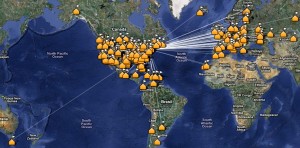This past weekend was the 24 hour JARTS RTTY ham radio contest. Looking back at my old posts, this is the 3rd year I’ve participated in this contest, and my score and time operating has decreased with 2008’s contest yielding the highest QSO count and 2009’s contest in the middle for QSO count. So how did things go this year?
I operated a couple of hours at the start of the contest in what was a very windy evening. I did a quick scan on 20m where I snagged Alaska and then spent the evening on 40m & 80m. PJ4B operating from the new DXCC entity was in the contest and I worked it without any wait. I also worked PJ4B on 15m as well as PJ4D on 15m during the contest. 80m was noisy but workable and I even had a little run on 80m before calling it a night at 11:30pm (0330z) with 72 Q’s in the log.
Saturday I had to wake the kids up early to go take the PSAT’s. I got on for a few hours after that and before I needed to head out to a high school football game. The weather outside was still extremely windy. 15m was pretty good this weekend for me. I could work more stations on 15m then I could in the past few weekends. Most contacts were on 15m and 20m. After a few mid day hours at the high school game I was back on 15m & 20m for a couple more hours before I was off to dinner with my wife’s family.
I had checked 10m a few times during the day but didn’t hear anything. A bit before heading out to dinner I checked 10m again and was able to hear LU5FF in Argentina approximately 5000 miles away and worked him without much effort. I spotted him after making the contact and saw a bunch of US stations then jump in. I got home late Saturday evening and spent 30 mins after I got home on 40m & 80m logging anyone I could hear. I ended Saturday night with 213 Q’s and I didn’t think I’d have much more then that for the entire contest since I couldn’t operate much on Sunday.
Sunday morning I got up and started to get ready to head to the Giants football game at the stadium. The wind had finally subsided at it was relatively calm out with blue skies. I started with a scan of 40m to grab any station I could hear which yielded about 12 quick Q’s before switching to 20m for another 10 Q’s before turning off the radio to head to the stadium. 8.5 hours later after getting home and unloading the car I popped on for a bit at the end of the contest. The frequency that the radio was on when I turned it on had a VK station calling CQ and I was able to work him for the only VK contact. After spotting him, there was a jump in activity on the frequency. I did hear 1 other VK but he couldn’t hear me and while I listened to other ops try to contact him, they couldn’t be heard either. I scanned 20m for any new stations and then called CQ for a little bit to get some of the S&P only stations. It was dark out now so I switched to 40m and did the same thing – scan and then call CQ. 40m yielded another dozen Q’s. A quick scan of 20m showed little activity so with 15 mins left in the contest I scanned 80m and then started to call CQ which was productive for those 15 mins. I logged a bunch of VE stations in Canada and I finished the contest with exactly 300 Qs logging NP3D (in NY) at the end. I’m surprised I worked 87 Q’s on Sunday when I didn’t think I’d get much time on, but I’m not complaining!
Here’s a map (click to enlarge) of the ham radio contacts that were made over the weekend:

Here’s the N1MM score summary for the contest:
Band QSOs Pts Cty Sec 3.5 55 110 1 11 7 61 126 9 14 14 142 340 31 14 21 41 97 11 9 28 1 3 1 0 Total 300 676 53 48 Score : 68,276
73 & thanks for all the Q’s,
K2DSL


